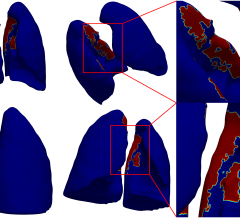October 11, 2013 — People over 60 years old are more likely to have precancerous or cancerous polyps develop in a part of the colon that goes unseen by flexible sigmoidoscopy, a common screening test for colon and rectal cancer, a new clinical study finds. Study results suggest the need for reviewing and possibly revising national colon cancer screening guidelines, study authors said at the 2013 Clinical Congress of the American College of Surgeons.
Colonoscopy is the most accurate way to find and remove small polyps before these growths can become colon cancer, the second leading cause of cancer death in the United States in men and women combined, according to the American Cancer Society.[1] However, some patients prefer a procedure called sigmoidoscopy because it is usually easier for them to undergo and quicker for gastroenterologists and surgeons to perform. The U.S. Preventive Services Task Force recommends screening for colorectal cancer in adults ages 50-75 using either colonoscopy every 10 years or sigmoidoscopy every five years plus fecal occult blood testing (a check for blood in the stool) every three years.[2]
A research team from Carolinas Medical Center in Charlotte, N.C., found that polyps in patients ages 60 and older occur more often in the beginning part of the colon on the right abdominal side, rather than the left side, lower end of the colon, as previously thought. The researchers used a colonoscopy procedure, which enables the physician to see the inside of the rectum and the entire colon. Sigmoidoscopy allows a view of only the rectum and sigmoid colon, the lower part of the colon on the patient's left side nearest the rectum and anus.
"Based on our results, patients older than 60 should strongly consider having a colonoscopy to screen for colon cancer," said Principal Investigator B. Todd Heniford, M.D., FACS, professor of surgery and chief of gastrointestinal and minimally invasive surgery at Carolinas Medical Center. "With sigmoidoscopy, there's a chance of missing polyps that may become cancer or already are cancer."
Using a specially created software program to search their hospital's medical records, Heniford's research team identified more than 120,000 colonoscopies performed between June 2003 and October 2011 in patients ages 20-90. Of the polyps removed during these procedures, 72,960 had an identifiable location.
"This is one of the largest studies to date, if not the largest, that used colonoscopy to find where colorectal polyps most often originate and at what age," Heniford said. Although the greatest percentage of polyps (25.5 percent) came from the sigmoid colon, the researchers found that the predominant site for polyps differed with increasing age. Compared with patients 60 or younger, patients older than 60 were 1.6 times more likely to have a right-sided colon polyp, where colonoscopy — but not sigmoidoscopy — could detect it, Heniford reported.
The results reportedly did not differ between men and women. Heniford said the age difference was similar for the type of polyp that most often becomes cancerous (adenomatous) but was less pronounced for nondangerous polyps.
For each decade of age, the odds ratio of finding polyps in the sigmoid colon was 0.88 compared with 1.22 for the cecum at the beginning of the colon, and 1.30 for the ascending or right side of the colon above the cecum. Therefore, in a 70-year-old patient, a polyp would be about 2.5 times more likely to originate in the cecum or ascending colon compared with a 50-year-old patient, Heniford estimated.
Heniford's research colleagues for the study were: Victor B. Tsirline, M.D., MS; Igor Belyansky, M.D.; Chelsea Conroy; William Yokeley; Amanda L. Walters, MS; Amy E. Lincourt, Ph.D., MBA; Vedra Augenstein, M.D.; and Ronald F. Sing, DO, FACS.
References:
1. American Cancer Society. What Are the Key Statistics About Colorectal Cancer? Available at: http://www.cancer.org/cancer/colonandrectumcancer/detailedguide/colorec…. Accessed August 23, 2013.
2. U.S. Preventive Services Task Force. Screening for Colorectal Cancer: Recommendation Statement. October 2008. Available at: http://www.uspreventiveservicestaskforce.org/uspstf08/colocancer/colors…. Accessed August 23, 2013.


 August 29, 2025
August 29, 2025 









